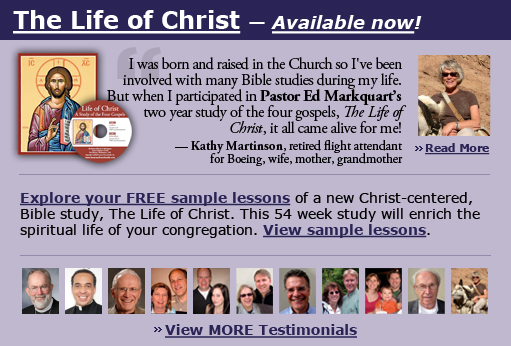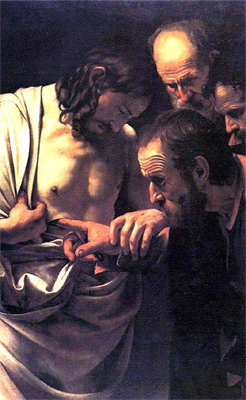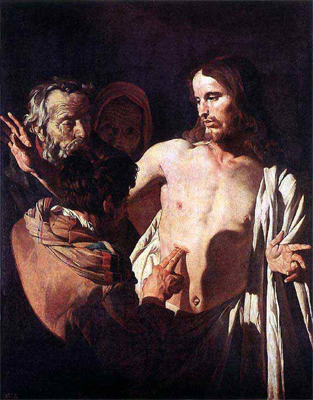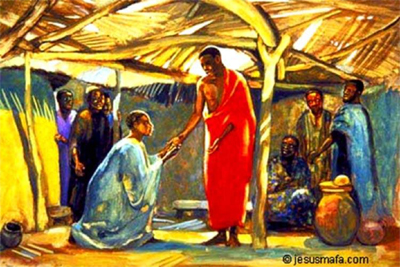
Christmas
Easter
Pentecost
All Saints
Christ The King
Confirmation
Palm/Passion
Reformation
Stewardship
Books of the Bible
Lenten Series
Christmas Dramas
Videos
Series A - Matthew
Series B - Mark
Series C - Luke
Series D - Other
To contact
Edward F. Markquart
info@sfs.com

Series A
EASTER 2A The following Bible study is from a larger course entitled THE LIFE OF CHRIST: A Study in the Four Gospels. This 54 week course for the laity will be available for congregations in 2008. Basic text for the course: SYNOPSIS OF THE FOUR GOSPELS, Kurt Aland, English Edition, P. 330-331. #356. Jesus Appears to his Disciples In the Gospel of John, this encounter with the disciples is the second resurrection appearance. The first resurrection appearance was to Mary Magdalene; the second was to the disciples (first without Thomas and then with Thomas); the third will be to the seven disciples on the Sea of Tiberias (Lake Galilee.) The Apostle John was counting those resurrection appearances. In John 21:14, we hear “This was the third time that Jesus was revealed to his disciples after he was raised from the dead.” -When it was evening on that day, the first day of the week, and the doors of the house where the disciples had met were locked for fear of the Jews, On that Sunday evening, the disciples were sequestered in a house and the doors of that house were locked because of their fear of the Jews/Pharisees/chief priests who had planned, plotted and pushed through the execution of Jesus. None of the disciples had yet seen the Risen Christ. None of the disciples had seen, touched, felt or connected with the Risen Christ. The disciples had only heard the story of what Mary Magdalene had seen. They themselves had not had a “first hand encounter” with the Christ of glory. -Jesus came and stood among them and said, ‘Peace be with you.’ Whoa! There was the Risen Christ, standing right in the middle of the group. How did Jesus get here? How did Jesus get into the house? The doors were locked. The disciples thought that they were safe from their cunning adversaries. Suddenly, for the first time, the Risen Christ was among them and talking to them face to face. He said “Peace. Peace be with you.” The first word from the Risen Christ to his disciples was “peace.” In his life, teachings and resurrection, Jesus came to be known as the Prince of Peace. We remember that Jesus gives a quality of peace that the world does not give. In the Gospel of John, this was the first experience of resurrection for the disciples. -(Luke’s only) T hey were startled and terrified, and thought that they were seeing a ghost. He said to them, ‘Why are you frightened, and why do doubts arise in your hearts? Look at my hands and my feet; see that it is I myself. Touch me and see; for a ghost does not have flesh and bones as you see that I have.’ And when he had said this, he showed them his hands and his feet. While in their joy they were disbelieving and still wondering, he said to them, ‘Have you anything here to eat?’ They gave him a piece of broiled fish, and he took it and ate in their presence. In his version of the event, Luke emphasizes that the disciples were startled, terrified and thought they were seeing a ghost. His disciples were filled with doubts, especially since they thought they were seeing an apparition or a mental fantasy. To counter the disciple’s doubt, Jesus asked his disciples to touch his hands, feet and side and thereby prove that he was not a figment of their collective imagination. To counter the disciples’ doubts, Jesus asked for something to eat and he ate a piece of boiled fish, thereby demonstratingthat he was not a mental apparition. The theme of Jesus’ demonstrating to his disciples his actual presence is also found in John’s gospel. In this resurrection appearance, notice that the body of Christ has wounds from the crucifixion. The wounds from the scourging are not emphasized in this gospel as they are in the movie, THE PASSION. In the Gospel of John, the wounds on Jesus’ hands and feet are emphasized. In the movie of THE PASSION, the sadistic whipping and stripping of Jesus’ body with thousands of riplets of blood are emphasized. The scourging during the movie, THE PASSION, made for gripping, cruel drama that appealed to human sadistic impulses, but the intense whipping and scourging to Jesus’ body was not emphasized in the Biblical account on Good Friday nor in the Biblical account of the resurrection stories. -After he said this, he showed them his hands and his side. The first thing that the Risen Christ did with his disciples was to show them his hands and side. John’s gospel does the same thing as the Gospel of Luke was doing. That is, both the Gospels of John and Luke demonstrate that the Risen Christ was not a ghostly apparition or figment of the imagination. The disciples could actually see Jesus’ hands and his side. -Then the disciples rejoiced when they saw the Lord. It was then, when their minds were satisfied that he Jesus was not a ghost, the disciples rejoiced because they knew that they were seeing their Lord. -Jesus said to them again, ‘Peace be with you. As the Father has sent me, so I send you.’ When Jesus first came, he pronounced peace upon them and he did so a second time. The Risen Christ was the Prince of Peace and his disciples were to become people of peace. He then laid down his mission plans: that the disciples were to be sent as he, himself, had been sent down to the earth by his heavenly Father. -When he had said this, he breathed on them and said to them, ‘Receive the Holy Spirit. After he said this, he breathed on them or blew wind on them and said, “Receive the Holy Spirit.” In the Gospel of John, the Holy Spirit came on the community at this moment in the story and not later (as in the Pentecost story via the Book of Acts.) When the disciples received the Holy Spirit in the Gospel of John, there was no emphasis about speaking boldly for Jesus Christ and becoming his witnesses to the ends of the earth. Instead, having received the Holy Spirit, the disciples were entrusted with the power to declare sins as either forgiven or retained. -If you forgive the sins of any, they are forgiven them; if you retain the sins of any, they are retained.’ This is the power of the keys that we studied earlier, the power to forgive or condemn sins. In the liturgy for Sunday morning worship in most mainline congregations, after the confession of sin, a pastor declares God’s forgiveness of sin. For centuries, pastors in the Church of Christ have echoed this continuing declaration of forgiveness. It is part of the office of the keys: “To the genuinely penitent, as an ordained pastor of Jesus Christ, I declare to you the entire forgiveness of all your sins.” But there is a negative side to that pronouncement. “And to those who are not penitent, I declare to you that your sins are not forgiven.” In the Gospel of John, the experience of this particular resurrection story to the disciples has several highlights e.g.
#357. Jesus Appears To His DisciplesJESUS APPEARS TO HIS DISCIPLES -But Thomas (who was called the Twin), one of the twelve, was not with them when Jesus came. This story is a continuation of the previous story. It is one longer story about the disciples’ first encounter with the Risen Christ, but the story comes with two parts: Jesus’ appearance to the disciples without Thomas and his appearance to the disciples with Thomas. We discover that Thomas was a twin and was called that as a nickname. The Twin, Thomas, was not with the other disciples when Jesus first appeared to them. -So the other disciples told him, ‘We have seen the Lord.’ The other ten disciples knew that they had seen the risen Lord. -But he said to them, ‘Unless I see the mark of the nails in his hands, and put my finger in the mark of the nails and my hand in his side, I will not believe.’ This line spoken by Thomas has become famous and symbolic: “Unless I see with my own eyes and the resurrection is proven to me, I will not believe.” Thomas becomes a symbol of skepticism and doubt, twin hallmarks of the twentieth and twenty-first century minds. Thomas wanted proof, and skeptics of all centuries have wanted proof rather than faith. -A week later his disciples were again in the house, and Thomas was with them. As in all intriguing stories, time passes. The disciples were together and Thomas was with them this time. -Although the doors were shut, Jesus came and stood among them and said, ‘Peace be with you.’ Once again the doors were shut. Once again the Risen Christ miraculously appeared and stood in their presence. Once again, the Risen Christ greets the disciples with his offer of peace to them. -Then he said to Thomas, ‘Put your finger here and see my hands. Reach out your hand and put it in my side. Do not doubt but believe.’ Jesus was offering the evidences of the wounds and his side. And then Jesus gave that classic line: “Stop doubting and believe.” That is what Thomas needed to do. Two things: First, stop doubting. And secondly, start believing. -Thomas answered him, ‘My Lord and my God!’ Without touching Jesus’ hands and without touching the wound in his side, Thomas confesses the most profound yet simple confession of faith: “My Lord and my God.” This is what Christ is looking for from us: that we come to that time or place in our lives where we simply confess, “Jesus, you are my Lord and my God.” The confession is personal: “You are my Lord; you are my God.” Simply put: that is what Jesus wants from us as well. -Jesus said to him, ‘Have you believed because you have seen me? Blessed are those who have not seen and yet have come to believe.’ That is our situation today. We have not seen the way Thomas saw and experienced the Risen Christ. The most blessed people in the world are those who come to believe but have not physically seen.
Related Sermon: Painting and the Imagination
Caravaggio
Honthorst
MAFA |
|


